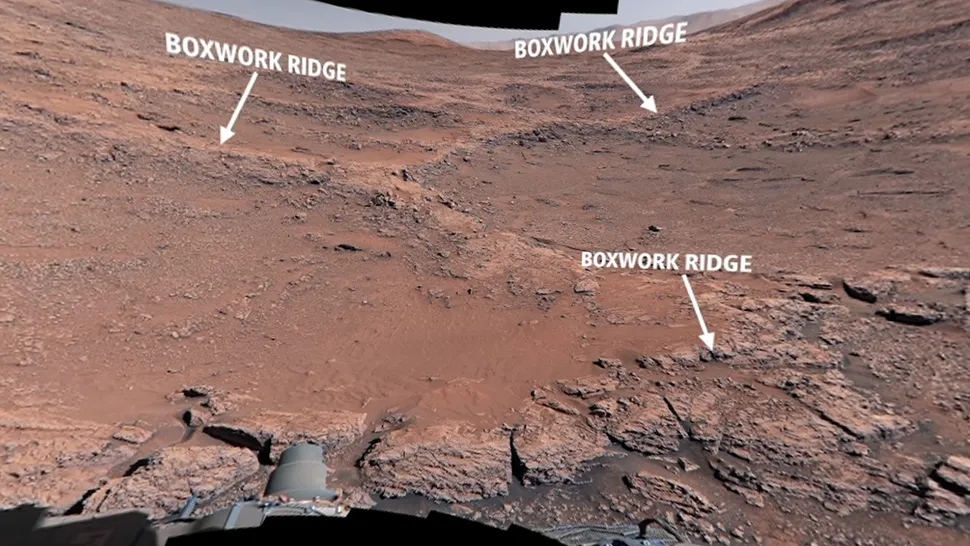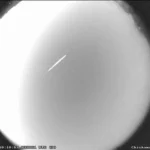The enigmatic surface of Mars continues to yield captivating discoveries, each providing a new piece of the puzzle regarding the Red Planet’s deep past.
In a significant breakthrough, NASA’s Curiosity rover has achieved a monumental milestone, capturing the first-ever close-up images of colossal Martian features resembling intricate “spiderwebs.” These striking geological formations, officially known as “boxwork,” are not actual arachnid creations but rather a fascinating network of zig-zagging ridges. Researchers believe these features were painstakingly sculpted by the slow, persistent flow of ancient groundwater, offering invaluable insights into Mars’ once more hospitable environment.
The detailed study of these structures could unlock critical information about Mars’ watery past, a period when liquid water was abundant on its surface. More profoundly, these findings hold the potential to provide crucial clues about whether the planet once harbored extraterrestrial life.
The ability to examine these formations up close, a feat previously impossible, opens new avenues for scientific inquiry. It allows astrobiologists and geologists to analyze the mineralogical composition and structural details of these ancient water pathways, which could have served as potential niches for microbial life. This new data from Curiosity promises to deepen our understanding of Martian habitability through the eons.
Decoding Martian “Boxwork”: A Geological Marvel
The “boxwork” features are more than just visually striking; they are geological remnants offering a window into Mars’ subsurface history.
The Intricate Nature of Martian “Spiderwebs”
The web-like features observed by the Curiosity rover are formally identified as “boxwork.” These are geological formations composed of intricate, criss-crossing ridges made of mineral-rich rocks. While they might appear sporadically across the Martian landscape, their sheer scale makes them a unique spectacle. From the vast expanse of space, these patterns can span an astonishing distance of up to 12 miles (20 kilometers) across, giving the illusion that they have been spun by colossal, mythical arachnids. This visual resemblance from orbit is what earned them their evocative, if misleading, nickname of “spiderwebs.”
Despite their impressive size and prevalence when viewed from a distance, these specific “boxwork” structures on Mars had remained largely unstudied up close until now. Previous observations were limited to orbital imagery, which lacked the granular detail necessary for in-depth geological analysis. The Curiosity rover’s recent close-up examination marks a significant leap, providing the high-resolution imagery and contextual data required to understand their formation and implications fully.
This detailed view is crucial for distinguishing them from other Martian geological phenomena and for unlocking the secrets they hold about the planet’s past.
Terrestrial Analogues and Formation Hypotheses
While the scale of Martian boxwork is grand, analogous smaller formations exist right here on Earth. These terrestrial versions are often found on the walls of caves and form through a similar geological mechanism to the more commonly known stalagmites and stalactites. In caves, water rich in dissolved minerals trickles through cracks, depositing these minerals and gradually building up hardened structures. Scientists have proposed that the same fundamental geological processes are responsible for the creation of these massive structures on Mars, albeit on a much larger and more ancient scale.
NASA representatives further elaborated on the accepted scientific hypothesis for their formation. In a recent statement, they explained that “The bedrock below these ridges likely formed when groundwater trickling through the rock left behind minerals that accumulated in those cracks and fissures, hardening and becoming cementlike.” This process, known as mineral precipitation or mineralization, effectively fills subterranean fractures with more durable material.
Subsequent geological forces and erosion play a crucial role in exposing these hardened networks. Over “eons of sandblasting by Martian wind,” the softer surrounding rock was gradually worn away, but the more resistant, mineralized ridges remained, revealing the intricate networks visible today. This erosional process, driven by persistent Martian winds carrying abrasive sand, selectively carves out the landscape, leaving behind the tougher mineral veins as raised structures, much like veins protruding on an old hand.
Distinguishing From “Spiders on Mars”
It is crucial to differentiate the “boxwork” features captured by Curiosity from another similarly named, but entirely distinct, Martian phenomenon: the infamous “spiders on Mars.” While both evoke arachnid imagery, their origins and compositions are fundamentally different. The “spiders on Mars” are a unique geological feature created by the seasonal sublimation of carbon dioxide (CO2) ice on the planet’s surface. As the sun warms the polar ice caps in spring, subsurface CO2 ice turns directly into gas.
This gas, trapped beneath layers of ice, eventually erupts through cracks, carrying dark dust with it, forming spider-like radial patterns. These are dynamic, seasonal features, not permanent mineral structures.
Recently, scientists successfully recreated these “spiders on Mars” on Earth for the first time, providing further insights into their formation mechanics. This successful terrestrial replication underscored their ephemeral, ice-driven nature. In contrast, the “boxwork” structures that Curiosity is studying are made of mineral-rich rocks, formed by ancient groundwater, and represent stable, long-lasting geological formations. Confusion between the two is understandable given their nicknames, but their differing origins — one cryogenic and seasonal, the other mineralogical and ancient — highlight the diverse geological processes at play on the Red Planet.
Curiosity’s Mission Focus: Gale Crater and Mount Sharp
The rover’s current location is strategic, offering unparalleled opportunities to study these unique formations and their context.
A Targeted Exploration on Mount Sharp
NASA’s Curiosity rover is currently engaged in a highly targeted exploration mission on the slopes of Mount Sharp, a towering central peak standing 3.4 miles (5.5 kilometers) tall, located at the heart of the vast Gale Crater. This crater, where the wandering robotic geologist famously touched down in 2012, has been Curiosity’s primary exploration site for over a decade. The rover’s journey to this specific patch of boxwork on Mount Sharp began in November 2024, marking a deliberate and strategic maneuver to investigate these intriguing geological formations. Curiosity successfully arrived at the site earlier this month, initiating its detailed observational phase.
The choice of this particular location is not arbitrary. These “boxwork” features represent a priority target for mission scientists because of a baffling observation: the ridges do not appear anywhere else on Mount Sharp. This unique localization has perplexed experts, who currently have no idea why these specific formations are confined to this particular area of the mountain. This geological anomaly makes the current investigation particularly critical, as understanding their isolated presence could reveal crucial details about localized hydrological processes, mineral distribution, or erosional patterns that differ from other parts of the mountain. The mystery surrounding their exclusivity amplifies the scientific value of Curiosity’s current fieldwork.
Initial Findings: Calcium Sulfate Veins
On June 23, NASA made a significant public release, providing the first close-up images of the faux Martian “spiderwebs.” These images offer an unprecedented level of detail, allowing scientists and the public alike to examine the intricate patterns and textures of these mineral ridges. Complementing these still images, NASA also released an interactive video on their YouTube channel. This immersive tool enables viewers to virtually explore the site in 3D, providing a simulated field experience and a deeper appreciation for the scale and complexity of the boxwork formations.
Beyond visual documentation, Curiosity’s scientific instruments have been hard at work. The rover meticulously drilled and analyzed some samples of rocks surrounding the web-like ridges. The results of this analysis have provided a crucial piece of the puzzle: the samples contained distinct veins of calcium sulfate. This finding is highly significant because calcium sulfate is a salty mineral that is commonly left behind by groundwater as it precipitates from solution. The presence of this mineral further corroborates the hypothesis that these boxwork features are indeed remnants of ancient groundwater activity.
What makes this discovery even more “really surprising,” as noted by Abigail Fraeman, Curiosity’s deputy project scientist at NASA’s Jet Propulsion Laboratory, is that this particular mineral hadn’t been seen so far up Mount Sharp before. Its unexpected appearance at this elevation suggests a more widespread or complex history of subsurface water movement than previously understood, adding another layer of intrigue to Mars’ geological narrative.
Unlocking Mars’ Past and Future Habitability
The study of boxwork has profound implications for understanding Mars’ geological and potentially biological history.
Reconstructing Mars’ Watery History
The in-depth study of these “boxwork” formations through Curiosity’s close-up observations offers a powerful new avenue for researchers to learn more about Mars’ watery past. Scientists hypothesize that these mineralized cracks represent ancient underground plumbing systems where liquid water once flowed freely. By analyzing the composition of these mineral veins, the morphology of the ridges, and their geological context, scientists can reconstruct a more detailed picture of how water moved through the Martian subsurface. This could provide crucial data on the volume, duration, and chemistry of ancient groundwater.
This knowledge is vital for understanding the planet’s evolution before its oceans were stripped away by solar radiation. For billions of years, Mars had a thicker atmosphere and potentially vast bodies of surface water. Over time, solar winds and radiation slowly eroded its atmosphere, leading to the loss of its surface water.
Studying these underground remnants helps to fill in the gaps of this atmospheric and hydrological decline. Furthermore, future findings from the boxwork study could also shed new light on the giant subsurface ocean that was recently discovered deep below the Martian crust. If these ancient groundwater systems are somehow connected to or provide clues about the vast reserves of water ice hypothesized to exist beneath the surface today, it would revolutionize our understanding of Mars’ current hydrological cycle and its potential for future exploration and resource utilization.
Clues to Extraterrestrial Life
Perhaps the most compelling implication of studying the “boxwork” ridges is their potential to finally help settle the profound debate surrounding whether Mars once harbored extraterrestrial life. The presence of ancient groundwater is a key requirement for habitability, as liquid water is essential for all known forms of life. These mineral-filled cracks represent environments where water was present, potentially for extended periods, and crucially, where it would have been protected from the harsh surface conditions.
Kirsten Siebach, a Curiosity mission scientist at Rice University in Houston who has been actively studying the area, previously articulated this exciting possibility. She noted that “These ridges will include minerals that crystallized underground, where it would have been warmer, with salty liquid water flowing through.” This description paints a picture of a subterranean environment that could have provided a stable and protected habitat. Siebach drew a direct parallel to early life on Earth:
“Early Earth microbes could have survived in a similar environment.” This suggests that if life did arise on Mars, such underground, water-rich fissures could have been prime locations for its emergence and persistence. The discovery of specific minerals within these cracks could also indicate the presence of energy sources or chemical gradients that early microbes might have utilized. Therefore, the detailed examination of these boxwork features makes the current site an “exciting place to explore” in the ongoing quest to determine if life ever existed beyond Earth.
New Horizon for Martian Exploration
The unprecedented close-up images of Martian “boxwork” captured by NASA’s Curiosity rover represent a pivotal moment in our exploration of the Red Planet. These remarkable, web-like mineral ridges, formed by ancient groundwater, offer a unique geological record of Mars’ dynamic past. Located strategically on Mount Sharp within Gale Crater, these features provide crucial insights into the planet’s long-lost watery history.
The discovery of calcium sulfate veins within the surrounding rocks further solidifies the groundwater hypothesis and poses new questions about water distribution at higher elevations. Crucially, the study of these protective, subsurface environments could finally provide definitive clues regarding the potential for extraterrestrial life on early Mars.
As Curiosity continues its detailed analysis, documented transparently by NASA, the scientific community holds its breath for revelations that could redefine our understanding of Mars’ past habitability and its ongoing geological evolution. These “spiderwebs” are not just beautiful formations; they are tantalizing threads leading to some of the universe’s most profound answers.








